
Official Edgar Rice Burroughs Tribute and Weekly Webzine Site
Since 1996 ~ Over 15,000 Webpages in Archive
Volume 0445
presents
Nkima's Chattering from the Shoulder #14
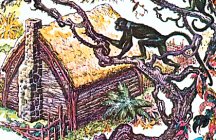
Tarzan’s Symbolic Home
By David A. Adams
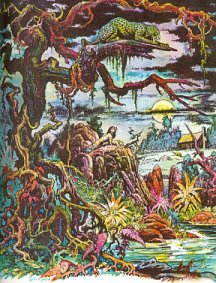
![]()



![]()
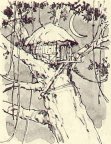 |
If you ask nearly anyone
in the world where Tarzan lived you would probably get the answer, “in
his tree house, of course!” Yet the Lord Greystoke created by Edgar
Rice Burroughs in his series of 25 books about Tarzan actually owned a
castle in England and spent most of his adult life upon a vast estate in
Africa. He was a civilized man of wealth and means who only roamed
from this comfortable setting into savage, lost cities to rescue wayward
explorers and fair maidens, or to replenish his supply of gold ingots and
jewels from the treasure vaults of Opar.
There is no doubt that the public view of Tarzan created by the many movies about this jungle hero completely overrides the view his creator had of him. Tarzan, Jane, and Boy living in a tree house with all of its clever amenities a’la the Swiss Family Robinson will always be the way most people will view the ape man. This Hollywood tree house is a bit of civilization in the wild, and at least symbolically, it is not so far from Tarzan’s childhood home described in the books, although built on a much more elaborate scale. |
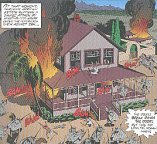
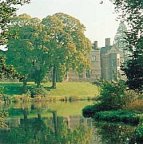 |
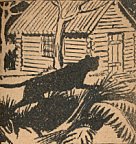
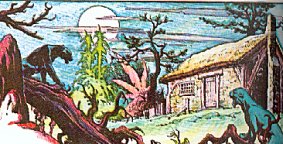
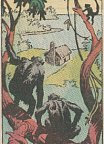
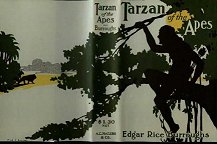 |
The cabin in the books was
a rather simple affair, no more than a single room built from logs and
filled with crude, handmade furniture. It was build by Lord Greystoke senior,
Tarzan’s father, when he and Lady Alice were marooned on the shores of
Africa in the first novel of the series,
Tarzan of the Apes.
Much of the action of this first appearance of Tarzan takes place in or around this cabin on the shore, in fact, the cabin itself might be considered to be symbolic of Tarzan himself. Both the cabin and Tarzan stand perched upon the very edge of two worlds -- one civilized, one savage. |
Significantly, this cabin
was constructed by Tarzan’s noble father precisely on the shore of the
ocean -- which leads to the world at large -- and the edge of the jungle
-- which leads into a primitive world, where Tarzan grew up among the apes.
Thus Tarzan is a divided
child at birth. His heritage is noble and civilized, but his nurturing
is in the wild.
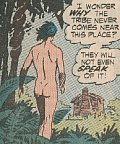

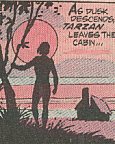
There are many ways this
cabin on the shore acts as a symbol in Tarzan of the Apes. The idea
for this article was suggested to me by reading Jerry Griswold’s “The Classic
American Children’s Story: Novels of the Golden Age.” Griswold’s
discussion of the symbolic nature of homes presented in Mark Twain’s “Adventures
of Huckleberry Finn,” led me to expand this idea in relation to Tarzan
of the Apes, which he also covers in his book with remarkable skill.
Griswold implies that American children’s stories have many themes in common,
and he left the symbolic nature of Tarzan’s boyhood home as a hint in his
discussion of Twain.
 |
Here is the true picture of Tarzan’s boyhood home, at least the civilized portion of it that is left for him by his father on the edge of the jungle. His parents were, as I mentioned above, marooned upon this landlocked bay. After spending a single night on a platform in the trees, which foreshadows the life among the apes of their son yet to be born, John Clayton, Lord Greystoke, begins building a house. | 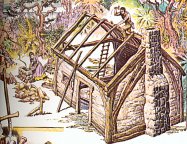 |
As soon as they had made their meager breakfast of salt pork, coffee and biscuit, Clayton commenced work upon their house, for he realized that they could hope for no safety and no peace of mind at night until four strong walls effectually barred the jungle life from them.Thus, Tarzan’s father left his son a tiny piece of civilization in the jungle that would become his touchstone with a world he would not experience in its fullness for many years. Moreover, the cabin itself becomes a touchstone about which the entire novel revolves.
Here is Burroughs’ detailed
description of the little cabin on the shore. Because of its importance
to the plot of the novel, it is necessary to observe it exactly as it was
presented, almost like a stage setting for the many events that will transpire
in this tiny dwelling.
 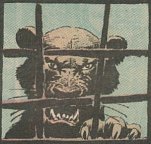 |
The task was an arduous
one and required the better part of a month, though he built but one small
room. He constructed his cabin of small logs about six inches in
diameter, stopping the chinks with clay which he found at the depth of
a few feet beneath the surface soil.
At one end he built a fireplace of small stones from the beach. These also he set in clay and when the house had been entirely completed he applied a coating of the clay to the entire outside surface to the thickness of four inches. In the window opening he set small branches about an inch in diameter both vertically and horizontally, and so woven that they formed a substantial grating that could withstand the strength of a powerful animal. Thus they obtained air and proper ventilation without fear of lessening the safety of their cabin. The A-shaped roof was thatched with small branches laid close together and over these long jungle grass and palm fronds, with a final coating of clay. The door he built of pieces of the packing-boxes which had held their belongings, nailing one piece upon another, the grain of contiguous layers running transversely, until he had a solid body some three inches thick and of such great strength that they were both moved to laughter as they gazed upon it. |
Here the greatest difficulty confronted Clayton, for he had no means whereby to hang his massive door now that he had built it. After two days' work, however, he succeeded in fashioning two massive hardwood hinges, and with these he hung the door so that it opened and closed easily.The stuccoing and other final touches were added after they moved into the house, which they had done as soon as the roof was on, piling their boxes before the door at night and thus having a comparatively safe and comfortable habitation.
The building of a bed, chairs, table, and shelves was a relatively easy matter, so that by the end of the second month they were well settled, and, but for the constant dread of attack by wild beasts and the ever growing loneliness, they were not uncomfortable or unhappy.
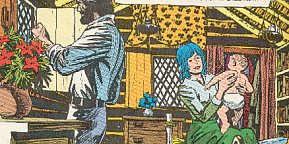
Here is what happened in and around the cabin:
Infancy
| 1. Tarzan is born here. | 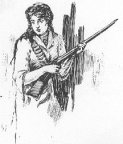 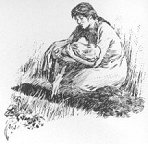 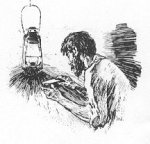 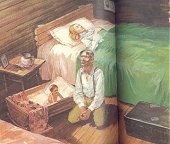 |
| 2. His mother dies here
3. His father is killed here 4. Tarzan is rescued from death here by Kala, his ape foster mother |
 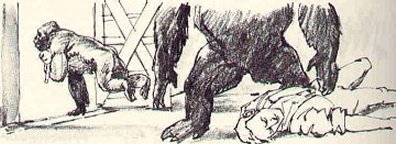 |
| Significantly, the cabin door is locked by the departing Kerchak after killing Lord Greystoke. Tarzan will be locked out of this side of his life, during which he will be raised by the great apes of the jungle. |  |
| When Tarzan grows up, he finds the cabin again, and by his superior human intelligence, he is able to open this time-capsule to civilization. Here Tarzan begins to equip himself for his human life. | 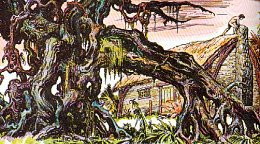 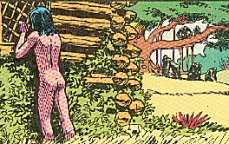 |
| Childhood
1. Tarzan finds his father’s knife. 2. Tarzan teaches himself how to read by studying the books in the cabin. 3. Tarzan finds a gold locket with the picture of his father, which he wears as a symbolic talisman of his life to come. The finding of his father’s knife, for all of the psychological overtones it implies, gives Tarzan the edge over the much stronger apes, and by using this tool of civilization, he eventually becomes the King of the Apes. |
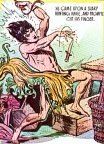 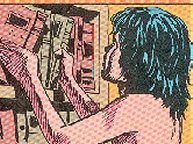
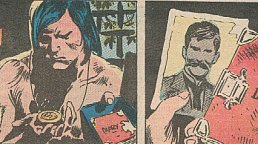  |
| Although it seems quite
fantastic, Tarzan teaches himself to read through the use of a picture
book and an English dictionary. Oddly enough, he cannot read his
father’s diary since it is written in script and in French, so he does
not discover his true identity until much later. Burroughs held back
this revelation for his ape child until he should meet human beings of
his own race during his maturity.
The diamond studded locket with his father’s picture acts as a mysterious symbol that confuses Jane when she first meets Tarzan since she does not know that he is Lord Greystoke’s son. This locket later takes a symbolic journey of its own in subsequent novels in a playful way, demonstrating Burroughs’ love of intricate little mysteries that run parallel to his main plot line. |
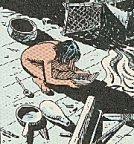 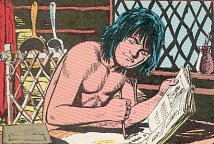
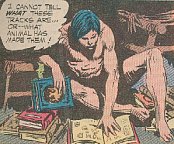 |
Adulthood
| 1. Tarzan sees his first white men and women here, and leaves a note on the cabin door warning that this cabin and its contents belong to him. Tarzan feels a sense of ownership for this little piece of civilization, even though he does not really understand its full meaning. | 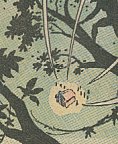 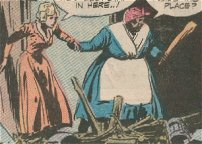 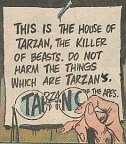 |
| 2. The skeleton of Kala’s ape baby is discovered in Tarzan’s cradle. This is perhaps one of the most telling symbols of all belonging to the contents of the cabin. It has been here all during Tarzan’s childhood, yet he did not pay it any attention along with his own parent’s skeletons, which makes this place a tomb as well as a symbolic womb. It is a mysterious, cool place of life and death on the very edge of Tarzan’s life. |  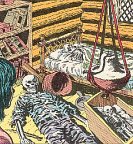 |
| 3. Tarzan saves Jane and her black maid, Esmeralda, from a Sabor, a female lion that is trying to enter the cabin through the heavily grated window that his father designed to protect his own wife from the wilderness. Tarzan succeeds in saving his future mate from the cruelty of the savage jungle as it tries to break into this tiny fortress of civilization. | 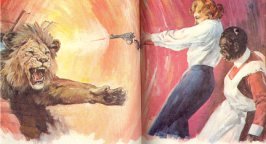  |
| Later on Tarzan spies on
Jane through the window. He does not try to break through forcibly
like the lioness. In a sense, Jane is safe in a civilized setting
in this cabin, while Tarzan is yet a beast of the wilderness looking in
at what might be.
Some critics of ERB have been confused by this seemingly voyeuristic scene by the noble ape-man. It has been explained as a normal lack of sophistication on Tarzan’s part at this stage of his life, or even as an echo of Mary Shelly’s “Frankenstein,” who learned about humans this way. However, if the cabin does indeed act as a significant symbol in the novel it may also be a way that Tarzan looks into a world that is expanding under his eyes within the cabin itself. Other people have never been here before, so he is seeing a greater world come to life within his childhood home, while he stands outside in his childhood life that is about to become something more. |
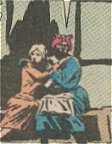
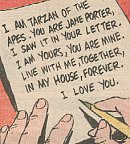  |
| It is only when Jane leaves the safety of the cabin and is attacked by the ape, Terkoz, that Tarzan can truly save her on his own ground, the jungle. Jane falls in love with Tarzan in the depths of the forest, but he returns her to the cabin, a civilized place where she seems to belong. | 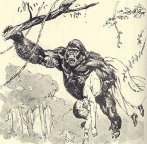 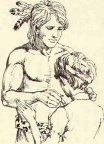 |
| 4. Tarzan is nearly killed
by D’Arnot at his cabin, but this Frenchman becomes the man who introduces
the ape man into the greater world outside his jungle home. The great
civilization of the outer world that will most influence Tarzan in his
early life will be French in the museums and libraries of Paris.
Jane and the other white people are not clear about Tarzan’s true identity, so they leave the jungle. There is a great deal of confusion and duplicity surrounding Tarzan’s introduction to the world outside. The cabin that was once a safe haven and a link to Tarzan’s relationship with civilization has become corrupted by the outside world. The expansion of Tarzan’s world is full of new dangers for him, which he must meet with the knowledge he gained in this little room. |
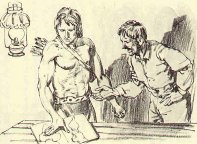 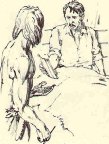
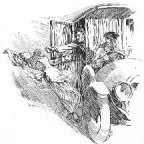 |
| 5. In the second novel of
the Tarzan Series,
The Return of Tarzan, the ape man is washed
up upon this very shore again after a series of adventures and misadventures
in the greater world outside.
With long sweeps of his giant muscles Tarzan sent the little craft speeding toward the beach. Its prow had scarcely touched when the ape-man leaped to shore--his heart beat fast in joy and exultation as each long-familiar object came beneath his roving eyes--the cabin, the beach, the little brook, the dense jungle, the black, impenetrable forest. The myriad birds in their brilliant plumage--the gorgeous tropical blooms upon the festooned creepers falling in great loops from the giant trees. |
 |
| Tarzan of the Apes had
come into his own again, and that all the world might know it he threw
back his young head, and gave voice to the fierce, wild challenge of his
tribe. For a moment silence reigned upon the jungle, and then, low and
weird, came an answering challenge--it was the deep roar of Numa, the lion;
and from a great distance, faintly, the fearsome answering bellow of a
bull ape.
Tarzan went to the brook first, and slaked his thirst. Then he approached his cabin. The door was still closed and latched as he and D'Arnot had left it. He raised the latch and entered. Nothing had been disturbed; there were the table, the bed, and the little crib built by his father--the shelves and cupboards just as they had stood for ever twenty-three years--just as he had left them nearly two years before. His eyes satisfied, Tarzan's stomach began to call aloud for attention--the pangs of hunger suggested a search for food. There was nothing in the cabin, nor had he any weapons; but upon a wall hung one of his old grass ropes. It had been many times broken and spliced, so that he had discarded it for a better one long before. Tarzan wished that he had a knife. Well, unless he was mistaken he should have that and a spear and bows and arrows before another sun had set--the rope would take care of that, and in the meantime it must be made to procure food for him. He coiled it carefully, and, throwing it about his shoulder, went out, closing the door behind him. |
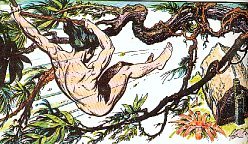
|
Burroughs mentions “the little
crib built by his father,” linking Tarzan with the events that began his
complicated life. Tarzan is no sentimentalist. He does not
sit down and ponder his past, but looks for weapons to renew his life as
a man of the wilderness.
| 6. At the end of The Return of Tarzan, he is married to Jane at the little cabin by her father, Professor Porter, who had in his younger days been ordained as a minister. The loose ends are all tied up at the symbolic cabin. Paul D’Arnot just happens to be there “cruising along the coast, on patrol duty,” so his friend who introduced him into the wide world is present for the ceremony. | 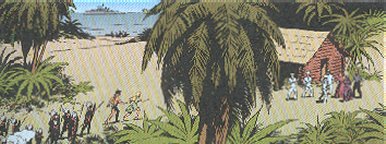 |
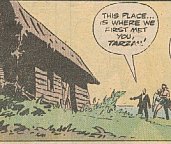
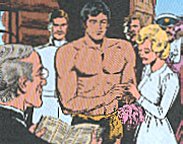
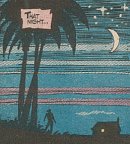
Nkima
July 7, 2000
2700 words
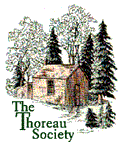
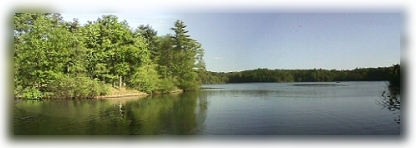
Addendum: Thoreau’s Cabin at Walden Pond It seems obvious that Tarzan’s little log cabin is also a reference to Americana -- Abraham Lincoln’s birth and childhood in a log cabin and especially to Thoreau’s cabin beside Walden Pond. As Thoreau put it:
“Near the end of March 1845, I borrowed an axe and went down to the woods by Walden Pond, nearest to where I intended to build my house, and began to cut down some tall, arrowy white pines, still in their youth, for timber” (36).
“I hewed the main timbers six inches square [the same size mentioned by ERB] most of the studs on two sides only, and the rafters and floor timbers on one side, leaving the rest of the bark on, so that they were just as straight and much stronger than sawed ones” (37).
Thoreau used boards from an Irishman’s shanty for the roof, and, like Clayton, he build a fireplace at one end of his one-room structure.
“I began to occupy my house on the 4th of July, as soon as it was boarded and roofed, for the boards were carefully feather-edged and lapped, so that it was perfectly impervious to rain, but before boarding I laid the foundation of a chimney at one end, bringing two cartloads of stones up the hill from the pond in my arms (40).
There are many similarities to be found in the Clayton and Thoreau cabins. Thoreau’s structure is the model ERB used in Tarzan of the Apes -- if not physically in every detail, it at least stands related in its rude, primitive beauty in a philosophical sense.
“I have thus a tight shingled and plastered house, ten feet wide by fifteen long, and eight-feet posts, with a garret and a closet, a large window on each side, two trap-doors, one door at the end, and a brick fireplace opposite” (43).
We do not usually think of Tarzan’s childhood as one of poverty or deprivation in any way. Of course, he is the Rousseauian child of nature, living among the apes, yet the cabin is a strong, safe haven that stands at the edge of both the physical world and his own mental and psychic one. It is a place that is somehow able to hold the fond memories of childhood for the readers of the Tarzan books as much as it does for Tarzan himself.
Much of Tarzan’s philosophy is an echo of Thoreau. How often have we come across a similar statement in ERB as this one?
“It is an interesting question how far men would retain their relative rank if they were divested of their clothes. Could you, in such a case, tell surely of any company of civilized men which belonged to the most respected class?” (20).
There are many interesting quotations found in Alan Hanson’s excellent book (The Wondrous Words of Edgar Rice Burroughs) that illustrate the basis of Tarzan’s philosophy, which in most cases match ERB’s own. It is a handbook that I heartily recommend to every ERB fan.
“So accustomed is civilized man to the strange apparel with which he has encumbered himself for generations that, bereft of it, his efficiency, self-reliance and resourcefulness are reduced to a place approximately the vanishing point.” (Tarzan At the Earth’s Core)
Hanson, Alan, The Wondrous Words of Edgar Rice Burroughs, Waziri Publications, 1998. (copy #76 of 100).
Thoreau, Henry David, Walden and Other Writings of Henry David Thoreau, Modern Library, 1950.
The End
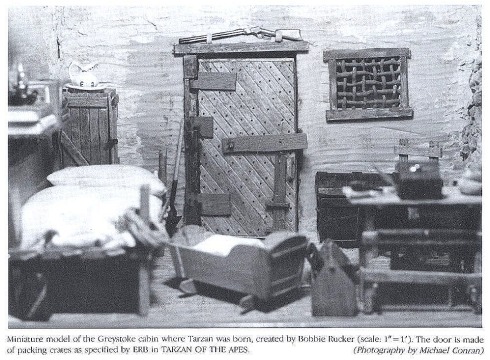
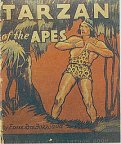
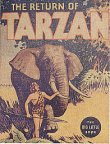
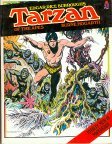
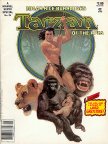
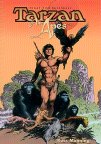

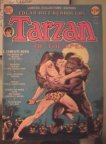
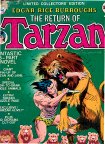

![]()
![]()
Volume
0445
![]()

![]()
BILL
HILLMAN
Visit
our thousands of other sites at:
BILL
AND SUE-ON HILLMAN ECLECTIC STUDIO
All
ERB Images© and Tarzan® are Copyright ERB, Inc.- All Rights Reserved.
All
Original Work © 1996-2006/2018 by Bill Hillman and/or Contributing
Authors/Owners
No
part of this web site may be reproduced without permission from the respective
owners.